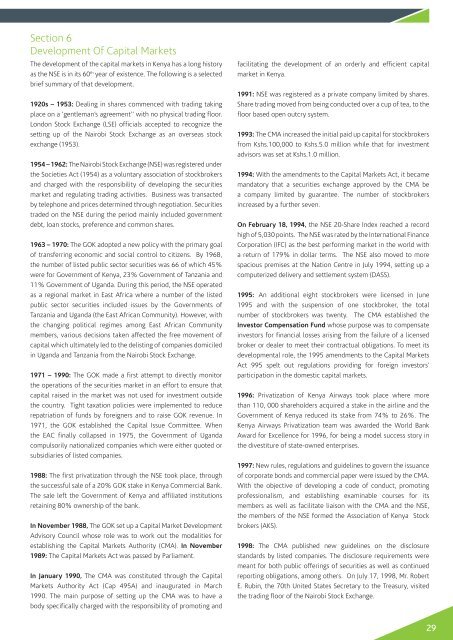NSE-Web-Prospectus-2014
NSE-Web-Prospectus-2014
NSE-Web-Prospectus-2014
- No tags were found...
Create successful ePaper yourself
Turn your PDF publications into a flip-book with our unique Google optimized e-Paper software.
Section 6Development Of Capital MarketsThe development of the capital markets in Kenya has a long historyas the <strong>NSE</strong> is in its 60 th year of existence. The following is a selectedbrief summary of that development.1920s – 1953: Dealing in shares commenced with trading takingplace on a ‘gentleman’s agreement’’ with no physical trading floor.London Stock Exchange (LSE) officials accepted to recognize thesetting up of the Nairobi Stock Exchange as an overseas stockexchange (1953).1954 – 1962: The Nairobi Stock Exchange (<strong>NSE</strong>) was registered underthe Societies Act (1954) as a voluntary association of stockbrokersand charged with the responsibility of developing the securitiesmarket and regulating trading activities. Business was transactedby telephone and prices determined through negotiation. Securitiestraded on the <strong>NSE</strong> during the period mainly included governmentdebt, loan stocks, preference and common shares.1963 – 1970: The GOK adopted a new policy with the primary goalof transferring economic and social control to citizens. By 1968,the number of listed public sector securities was 66 of which 45%were for Government of Kenya, 23% Government of Tanzania and11% Government of Uganda. During this period, the <strong>NSE</strong> operatedas a regional market in East Africa where a number of the listedpublic sector securities included issues by the Governments ofTanzania and Uganda (the East African Community). However, withthe changing political regimes among East African Communitymembers, various decisions taken affected the free movement ofcapital which ultimately led to the delisting of companies domiciledin Uganda and Tanzania from the Nairobi Stock Exchange.1971 – 1990: The GOK made a first attempt to directly monitorthe operations of the securities market in an effort to ensure thatcapital raised in the market was not used for investment outsidethe country. Tight taxation policies were implemented to reducerepatriation of funds by foreigners and to raise GOK revenue. In1971, the GOK established the Capital Issue Committee. Whenthe EAC finally collapsed in 1975, the Government of Ugandacompulsorily nationalized companies which were either quoted orsubsidiaries of listed companies.1988: The first privatization through the <strong>NSE</strong> took place, throughthe successful sale of a 20% GOK stake in Kenya Commercial Bank.The sale left the Government of Kenya and affiliated institutionsretaining 80% ownership of the bank.In November 1988, The GOK set up a Capital Market DevelopmentAdvisory Council whose role was to work out the modalities forestablishing the Capital Markets Authority (CMA). In November1989: The Capital Markets Act was passed by Parliament.In January 1990, The CMA was constituted through the CapitalMarkets Authority Act (Cap 495A) and inaugurated in March1990. The main purpose of setting up the CMA was to have abody specifically charged with the responsibility of promoting andfacilitating the development of an orderly and efficient capitalmarket in Kenya.1991: <strong>NSE</strong> was registered as a private company limited by shares.Share trading moved from being conducted over a cup of tea, to thefloor based open outcry system.1993: The CMA increased the initial paid up capital for stockbrokersfrom Kshs.100,000 to Kshs.5.0 million while that for investmentadvisors was set at Kshs.1.0 million.1994: With the amendments to the Capital Markets Act, it becamemandatory that a securities exchange approved by the CMA bea company limited by guarantee. The number of stockbrokersincreased by a further seven.On February 18, 1994, the <strong>NSE</strong> 20-Share Index reached a recordhigh of 5,030 points. The <strong>NSE</strong> was rated by the International FinanceCorporation (IFC) as the best performing market in the world witha return of 179% in dollar terms. The <strong>NSE</strong> also moved to morespacious premises at the Nation Centre in July 1994, setting up acomputerized delivery and settlement system (DASS).1995: An additional eight stockbrokers were licensed in June1995 and with the suspension of one stockbroker, the totalnumber of stockbrokers was twenty. The CMA established theInvestor Compensation Fund whose purpose was to compensateinvestors for financial losses arising from the failure of a licensedbroker or dealer to meet their contractual obligations. To meet itsdevelopmental role, the 1995 amendments to the Capital MarketsAct 995 spelt out regulations providing for foreign investors’participation in the domestic capital markets.1996: Privatization of Kenya Airways took place where morethan 110, 000 shareholders acquired a stake in the airline and theGovernment of Kenya reduced its stake from 74% to 26%. TheKenya Airways Privatization team was awarded the World BankAward for Excellence for 1996, for being a model success story inthe divestiture of state-owned enterprises.1997: New rules, regulations and guidelines to govern the issuanceof corporate bonds and commercial paper were issued by the CMA.With the objective of developing a code of conduct, promotingprofessionalism, and establishing examinable courses for itsmembers as well as facilitate liaison with the CMA and the <strong>NSE</strong>,the members of the <strong>NSE</strong> formed the Association of Kenya Stockbrokers (AKS).1998: The CMA published new guidelines on the disclosurestandards by listed companies. The disclosure requirements weremeant for both public offerings of securities as well as continuedreporting obligations, among others. On July 17, 1998, Mr. RobertE. Rubin, the 70th United States Secretary to the Treasury, visitedthe trading floor of the Nairobi Stock Exchange.29


